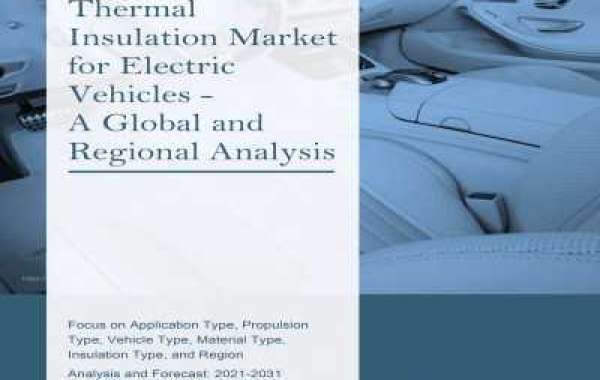
Acoustic and Thermal Insulation Market for Electric Vehicles is Projected to Reach $1,108.4 Million by 2031
The growth in the global acoustic and thermal insulation market for electric vehicles is attributable to the ongoing demand for innovative, lightweight, and efficient insulation materials for electric vehicles. Generally, for the context of determining a material’s thermal conduction on a flow of heat, the material’s R-value is calculated.
In the wake of the projected depletion of the global crude oil sources and the rising concerns over air pollution in many cities, automotive manufacturers are developing electric vehicles (EVs) as affordable, dependable, and safe alternatives to internal combustion (IC) engine vehicles. Further, increasing legislation in many parts of the world to decrease exhaust emissions from vehicles have led electric vehicle manufacturers to develop battery-electric or fully electric vehicles (BEVs).
Other types of EVs available are hybrid electric vehicles (HEVs) and plug-in hybrid electric vehicles (PHEVs). Electric vehicle sales have slowly gained momentum in many regional markets, but the market is still minuscule as compared to the global internal combustion engine-based vehicles market.
As various projections indicate that electric vehicles will eventually dominate the automotive industry, many existing vehicle manufacturers, along with several new players, have started aligning their company goals toward producing electric vehicles.
Read Report Overview: https://bisresearch.com/industry-report/global-acoustic-thermal-insulation-market-electric-vehicles.html
A major issue discovered along with the advent of EVs is the changes in noise, vibration, and harshness (NVH) properties of a vehicle. EVs are remarkably quieter than IC engine vehicles, mainly due to the absence of the noise produced from the gasoline engine and transmission systems.
Therefore, EVs can glide across a road without contributing to any noise and air pollution.
In fact, several regulatory bodies, such as National Highway Traffic Safety Administration (NHTSA) and the European Parliament, have passed regulations to add artificial sounds in electric vehicles to alert pedestrians while traveling at low speeds. Despite such a noticeable decrease in sound from an EV, there are other ancillary noises that are now prevalent in electric vehicles.
These noises, which were previously drowned out in an internal combustion engine vehicle, are now audible in the absence of engine noise.
An electric vehicle produces several new noises such as whining from powertrain drive and the electric motor, along with tire and external aerodynamic noises while the EV is moving. Buzz, squeak, and rattle (BSR) noise also become more apparent in an electric vehicle.
Such ancillary noises hamper the driving experience and also disturb the acoustics from sound systems or haptic feedback while driving the vehicle. Under these conditions, acoustic insulation in an electric vehicle is of great relevance.
The acoustic insulation quality in EVs needs to be enhanced to prevent not only noises entering the passenger cabin from outside the vehicle but also for noises from the insides of the vehicle, such as the vehicle HVAC system and the vehicle electric drive system.
Unlike in IC engine vehicles, electric batteries emit much less waste heat that can be used to heat the passenger cabins. Additionally, there is also a lack of power source for the compressor system in an electric vehicle, as earlier it was linked directly with the IC engine.
HVAC systems in an EV are needed to be powered electrically and hence derive power from the battery system in the vehicle.
Request a Sample: https://bisresearch.com/requestsample?id=1153type=download
The increasing application areas for insulation in an electric vehicle have led to the surging demand for various insulation materials such as foams, fibers, and rubber pads. Automotive OEMs have invested in fitting adequate amount of insulation in their electric vehicles to improve the driving experience, which in turn, can increase the electric vehicle sales.
Moreover, huge investments in the form of subsidies and infrastructure development by government and federal agencies to promote electric vehicles to cut down carbon dioxide emission are further propelling the growth of electric vehicle insulation materials. However, certain technical challenges, such as lack of global standards for electric vehicle insulation, along with finding suitable thermally resistive and lightweight materials for electric vehicles are restraining the growth of the global acoustic and thermal insulation market for electric vehicles.
The competitive landscape of the acoustic and thermal insulation market for electric vehicles consists of different strategies undertaken by major players across the entire value chain to gain market presence. Some of the strategies adopted by electric vehicle insulation material manufacturers are new product launches, business expansions, mergers and acquisitions, partnerships, and collaborations.
About Us:
BIS Research, a premium market intelligence company, offers in-depth insights and consulting to Fortune 500 companies. We are established and known for tracking the growth of deep technologies across key industry verticals and the subsequent challenges and opportunities associated with deep tech across markets, applications, and products.
With more than 1,000 clients, over 10,000 plus primary interviews, and approximately 200 reports published in a year, BIS Research has often been sighted for its ability to track emerging tech trends early on. We provide market estimations, analysis on emerging high-growth applications, technology analysis, highly segmented granular country-level market data, and other important market parameters that come in handy for our clients during strategic decision-making.